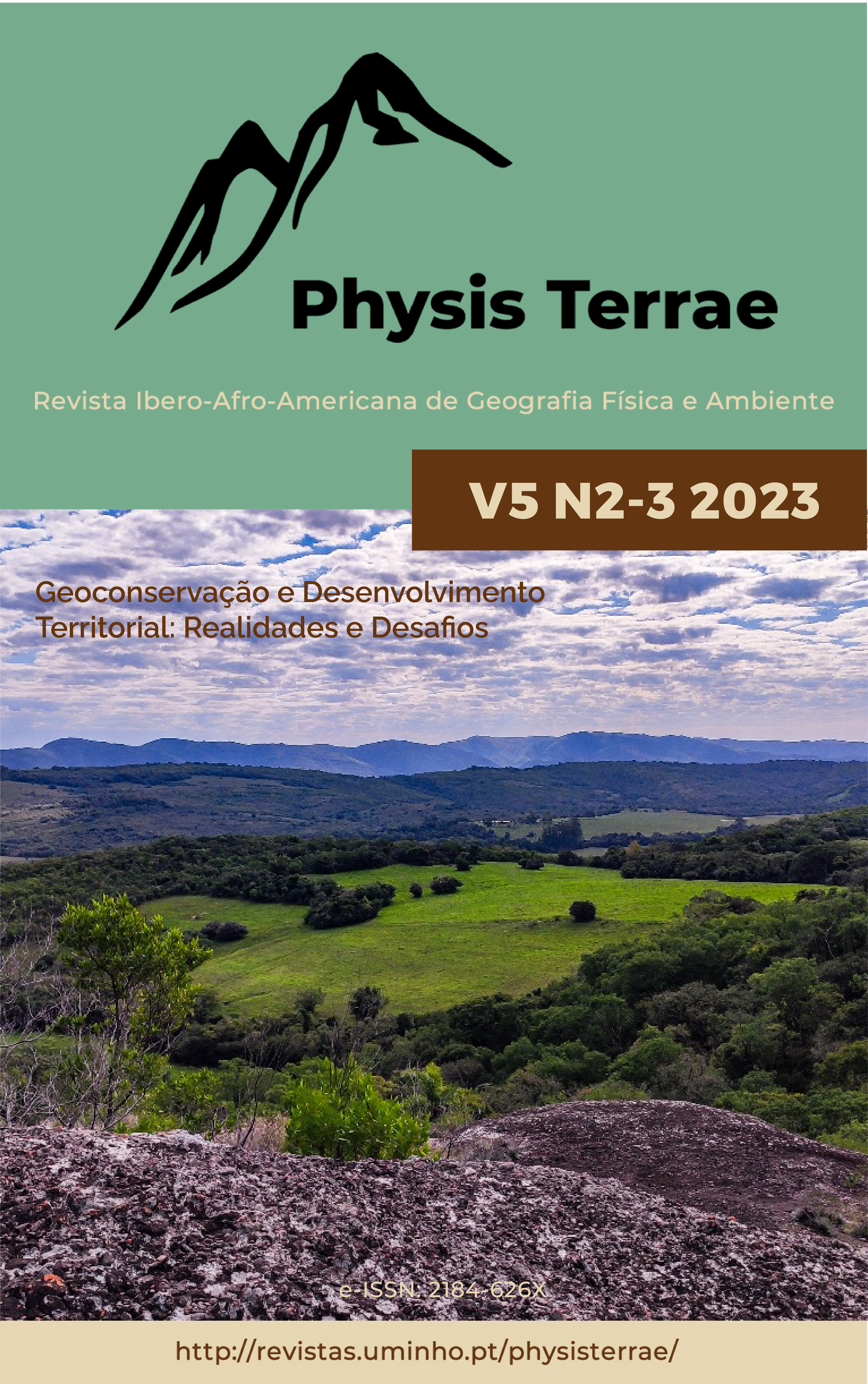“Pans and potholes”: important features of the geomorphological heritage of the Guaritas geosite, Caçapava Unesco Global Geopark
DOI:
https://doi.org/10.21814/physisterrae.5563Keywords:
Weathering, Erosion, Geomorphology, Gnamma, Guaritas geositeAbstract
In Caçapava do Sul/RS, municipality whose limits coincide with those of the Caçapava UNESCO Global Geopark, the Guaritas geosite is a highly dissected plateau developed upon the early Paleozoic Guaritas Formation. That stratigraphic unit comprises cross-stratified, pebble-bearing sandstones, conglomeratic sandstones, true conglomerates, as well as subordinated siltstones. On horizontal, flat floorings and flat hilltops, as well as along some creeks, weathering and erosion “rock basin” features occur. In order to understand their evolution, bibliographic reviews, field trips, detailed remote sensing by drones, execution of 3D models and testing with a Schmidt hammer were performed. The first set of these features comprises shallow, irregular excavations, generally elliptical and elongated (resembling “platters” or “frying pans''), which are linked to chemical weathering (so referred to as weathering pans), where accumulated standing rainwater acts chemically on sandstones/conglomerates. The second group is composed by regular, cylindrical, deeper holes (pits or potholes), excavated into the rocks by physical weathering, normally at the headwaters of fluvial systems: the running and swirling water of these streams, together with the conglomerate clasts extracted from the rocks (pebbles and cobbles), provokes friction in the rock, leading to the deepening of potholes. Besides the obvious scientific and educational value, knowledge about weathering pans and abrasion potholes can increase the tourist content of trails within the geosite, in addition to contributing to the conservation of native fauna and flora species.
Downloads
References
Almeida, F. F. M. (1969) Diferenciação Tectônica da Plataforma Brasileira. In Congresso Brasileiro de Geologia, 23, Salvador, Anais (pp 29-46).
Aydin, A., & Basu, A. (2005). The Schmidt hammer in rock material characterization. Engineering Geology, 81(1), 1–14. https://doi.org/10.1016/j.enggeo.2005.06.006
Borba, A. W. (2006) Evolução geológica da “Bacia do Camaquã” (Neoproterozóico e Paleozóico inferior do Escudo Sul-rio-grandense, RS, Brasil): uma visão com base na integração de ferramentas de estratigrafia, petrografia e geologia isotópica. Unpublished Ph.D. Thesis, Universidade Federal do Rio Grande do Sul, Programa de Pós-graduação em Geociências.
Borba, A. W. (2018). Avanços e obstáculos para a certificação de um geoparque em Caçapava do Sul, “Capital Gaúcha da Geodiversidade.” Terr@ Plural, 12(2), 201–210. https://doi.org/10.5212/TerraPlural.v.12i2.0004
Borba, A. W., Guadagnin, F. (2022). The Guaritas, Serra do Segredo, and Minas do Camaquã geosites of the ‘Caçapava UNESCO Aspiring Geopark’ (southernmost Brazil): world-class sites for Gondwanan sedimentation, tectonics, copper mining, and cavernous weathering research. Geoheritage, 14(1), 14. https://doi.org/10.1007/s12371-022-00648-1
Ceolin, A. C. G. (2018). Formação Guarda Velha, Caçapava do Sul, RS: modelo de afloramento análogo em sistemas aluviais.
Hall, A. M., & Phillips, W. M. (2006). Weathering pits as indicators of the relative age of granite surfaces in the cairngorm mountains, scotland. Geografiska Annaler: Series A, Physical Geography, 88(2), 135–150. https://doi.org/10.1111/j.0435-3676.2006.00290.x
Paes-de-Almeida, R., Janikian, L., Fragoso-Cesar, A. R. S., & Marconato, A. (2009). Evolution of a rift basin dominated by subaerial deposits: The Guaritas Rift, Early Cambrian, Southern Brazil. Sedimentary Geology, 217(1-4), 30-51. https://doi.org/10.1016/j.sedgeo.2009.01.010
Paim, P. S. G. (1994). Depositional systems and palaeogeographical evolution of the Camaquã and Santa Bárbara basins, Brazil. Unpublished Ph.D. Thesis, University of Oxford.
Pedroso, E. B., Pedroso, E., de Ávila Bitencourt, G., & Guadagnin, F. (2019). Geoparque Caçapava: uma iniciativa de desenvolvimento sustentável através da valorização do geopatrimônio de Caçapava-RS. In Anais do Salão Internacional de Ensino, Pesquisa e Extensão, 11(3).
Timms, B. V., & Rankin, C. (2016). The geomorphology of gnammas (weathering pits) of northwestern Eyre Peninsula, South Australia: typology, influence of haloclasty and origins. Transactions of the Royal Society of South Australia, 140(1), 28–45. https://doi.org/10.1080/03721426.2015.1115459
Twidale, C. R., & Bourne, J. A. (2018). Rock basins (gnammas) revisited. Géomorphologie: Relief, Processus, Environnement, 24(2), 139–149. https://doi.org/10.4000/geomorphologie.11880
Vieira, A., & Cunha, L. (2004). Património Geomorfológico – tentativa de sistematização. In Actas do III Seminário Latinoamericano de Geografia Física, Puerto Vallarta.
Downloads
Published
How to Cite
Issue
Section
License
Copyright (c) 2023 Felipe João Romansin, André Weissheimer de Borba, Anderson Augusto Volpato Sccoti, Felipe Guadagnin

This work is licensed under a Creative Commons Attribution 4.0 International License.


